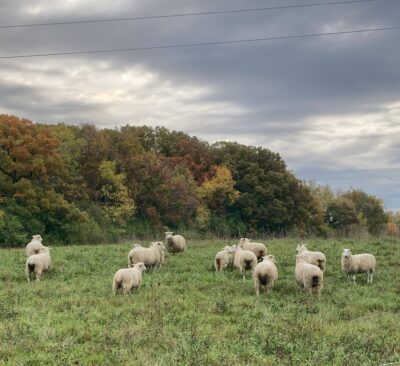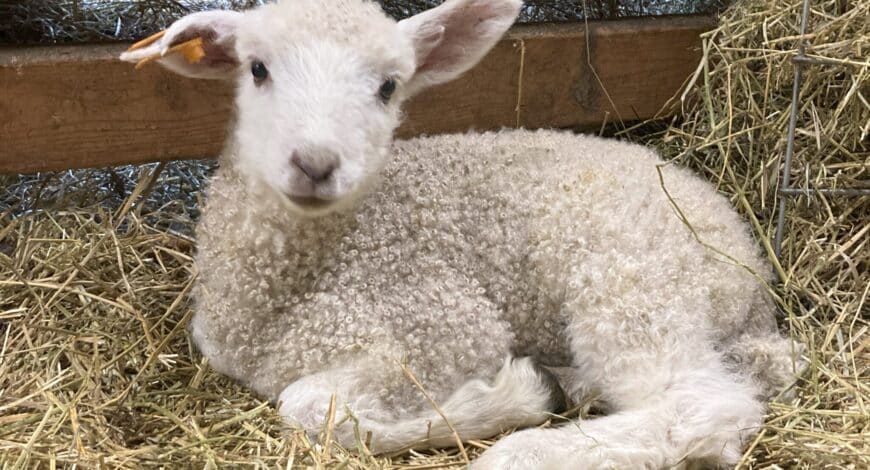
By Joshua Mechaelsen
Here at Gwenyn Hill, there are a thousand and one things that signify the start of a new growing season, but of all the things that embody spring, lambing has to rank near the top. What could be more springtime than fluffy frolicking lambs bouncing through new green grass?
Lambing is the term we use for sheep birth and it is the highlight of the shepherd’s year. While calves may be born in our dairy and beef herds throughout the year, all of our lambs arrive in a matter of days. That concentration of new arrivals heightens the excitement (and exhaustion?) of lambing season for everyone involved (including the ewes). So what exactly is it like in the sheep barn as it transforms from maternity ward to nursery?

Preparation for lambing season starts a few weeks prior to the highly anticipated due dates with Shearing Day. Actually, it starts even before that. In late summer, as temperatures flirt with autumn weather, our pastures have a surge of grass growth that coincides perfectly with the nutritional needs of our ewes. In high summer, our lambs are weaned and the ewes have time to rest and recover, recuperating the energy that they have spent raising up beautiful lambs on their rich milk. This is where September and October pasture growth plays such a critical role. If gestation and lambing are to be successful in the coming months, then the ewes need to have essentially the same quality forage in their diets as our dairy cows do. As body condition improves, so does the likelihood of a successful pregnancy and lambing.
Sometime in the second half of November our ewes and our ram will have the chance to become reacquainted with each other. This is without a doubt the most critical stage in ensuring that lambs will be born in the spring. About five months on from this reacquaintance, lambs will be born. So we expect our lambs around mid April.
If you follow along through the year with other sheep farms, you might notice that they are having lambs as early as February. So why are our lambs not born until April? The most important reason is that newborn lambs are easily chilled by early spring temperatures and this can easily lead to sickness or death. By pushing lambing to mid April, we are that much more likely to have mild weather, increasing the survivability of our lamb crop (yes that is actually how we in the sheep business talk about a year’s worth of lambs). April is also the time of year when our chore schedules and barn space offer the best opportunity for lambing. Finally, by mid April, fresh spring pastures are mere weeks away. This reduces the amount of time we have to keep lambs confined to the barn and the amount of hay we will have to feed them. As in September, nursing ewes and growing lambs need high quality forage, now in the form of last year’s hay, and by spring, that can be hard to come by.
But as I was saying, Shearing Day. Shearing prior to lambing is important for sheep and shepherd alike. Our long-wool sheep may grow seven inches or more of wool in a year. This gorgeous fiber can quickly become soiled and even ruined in the confines of the barn and through the birthing process. Long wool also makes it much harder to keep an eye on a ewe’s body in order to assess her condition and proximity to lambing. New born lambs too can become disoriented among the locks of wool and struggle to find that critical milk in their first hour of life. For all these reasons, shearing our ewes at least a month before lambing is a great way to set everyone up for success.

A few weeks later, when the lambs are being born, it’s go go go! We may not be quite as extreme as some shepherds who set up a cot in their lambing barn, but we’ll be sure to check them around 10:30 PM and then again 4:30 AM the following morning in addition to all the frequent checks throughout the day. If a ewe shows signs that she will imminently give birth, it’s important to keep an eye on her but also to not intervene too soon. Intervening too soon could increase the ewe’s stress and negatively impact the lambing process. On the other hand, it’s important to have the necessary tools on hand to intervene in a difficult birth if it becomes necessary. Thankfully, delivery complications are very much the exception rather than the norm in our flock.
Our ewes may have anywhere from one to four lambs. But because a sheep’s udder only has two teets, triplets and quads have to be supplemented with additional milk by feeding them with a bottle. Bottle feeding is exciting but it can also be difficult to ensure that lambs receive as much milk as they need. With its mother, a lamb may nurse every couple of hours, or even more frequently. That’s a lot of bottles! But who can resist the charm of a wobbly little lamb seeking out a warm bottle of milk? Certainly not us!
In a matter of days, a dozen or more lambs join our flock and the barn is transformed into a rambunctious playground for our newest arrivals. It is certainly a rewarding (if tiring) time for shepherd and sheep alike and signifies that spring is in full swing!
After living, working and studying in Iowa, Washington DC and rural England, Joshua Mechaelsen joined Gwenyn Hill Farm as the Land and Livestock Assistant in 2022.

